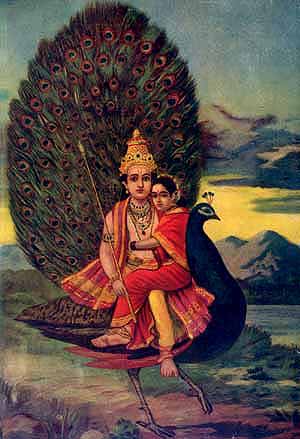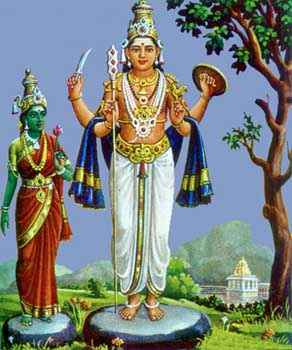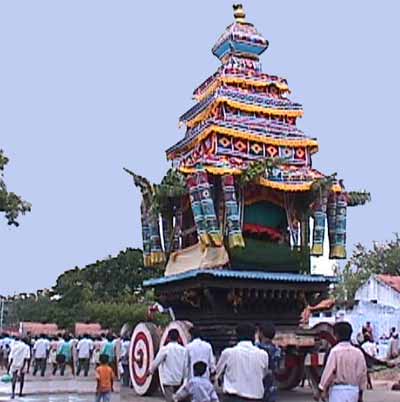
|
||||||||||||
|
| ||||||||||||
Vaikāsi Visākam and Lord MurukanSivanandini Duraiswamyவைகாசி விசாகமும் முருகப் பெருமானும்
The hallowed full moon day in the month of Vaikāsi, under the Visākam star is the Vaikāsi Pournima also termed Vaisāki Paurnima. The Vaikāsi moonlight floods the world with a glorious effulgence making the over arching sky infinite and vast. In our tropical skies, the moon, 'slowly and silently walks the night in her silver shoon.' The transparent clouds seem to salute her as she moves unhurriedly. This is indeed Nature's magnificence manifesting itself with an overwhelming grandeur. And with this mysteriously beautiful soft light of sanctity, comes a hush, deep and strange reminding the Hindus and Buddhists of the significance of this sacred day. It is well known that the asterism Visākam is considered to be the birth star of Murukan who is called Visākan. The Visāka asterism is a combination of three stars which shine brightly in the sky and its pattern in the sky resembles the torana or entrance. It is the fourteenth asterism in the month of Vaikāsi when the sun's vernal equinox falls which accounts for the hot days during this month. Vaikāsi Visākam is important to the Saivites, Vaishnavites and the Buddhists. To the Saivites, it is the day of the descent of Murukan; to the Vaishnavites it is Periyalvar's jayanti and to the Buddhists it is the day of the great miracles of nativity, enlightenment and maha samadhi of Buddha. The descent of Murukan is referred to as the Shanmuga avatāram. This descent was in answer to a prayer by the devas to rid the world of adharma caused by the three asura brothers, Soorapadman, Singamuhan and Tārakan. These brothers had obtaind great powers through intense penance and were harassing the devas. The devas appealed to Siva for help. Tradition has it that Siva added a sixth face to the existing five faces and this incident is spoken of in the celebrated work of Saint Kumaraguruparar as: Ainthu mukaththodatho
mukamum thanthu Saint Tirumular in his Magnum Opus, the Tirumantiram, over two thousand years ago referred to this Divine incident as: Āme pirān
mukamainthodu māruya From the forehead, Siva emitted six sparks of fire which enveloped the world with lustre. These sparks were carried by Vāyu and Agni to the Ganges which pushed them into Lake Saravanai filled with lotuses and reeds. Philosophically the lotus represents the pure heart and the reeds represent the network of nerves in man's physical body. Symbolically, the Divine Effulgence in the lake with its lotuses and reeds, are within each one. As Light and Life this Reality abides in the body, breath, senses, mind, intelligence and ego. These six facets of the human complex represents the six faces of Shanmugan. In the Lake the sparks became six Divine children and were nursed by six Kārtika maidens. These children were embraced by the Divine Mother and became One with six faces and twelve hands. And thus descended Shanmugan, the incarnation of pure consciousness and divine knowledge on the pournima (paruvam) in the month of Vaikāsi. Saint Kachchiappah Sivachariyar beautifully portrays the descent as, ‘With form and formlessness, without a beginning and as one and many, stood the column of Light, the Supreme Brahman, who with six merciful faces and twelve arms took the Divine Incarnation as Murukan for the redemption of the world,' Aruvamum uruvumāki
anāthiyāi palavāi onrāi He then goes on to say, ‘That ever pure, Omnipresent Siva, who cannot be comprehended by speech or mind or even by the Vedas, assuming the form of six sweet babes, was gracefully seated on six lotus flowers in the Saravana Lake.' Murukan is worshipped and adored also as Subramanyan, Shanmugan, Kārttikeyan, Guhan Saravanapavan, Arumugan etc. As Murukan, He is the ever young and beautiful; as Subramanyan, He is the Su Brahmanya the All-pervading spirit of the Universe – the essence from which all things are evolved, by which they are sustained and into which they dissolve. He is the Omnipresent One, the Commander-in-Chief seated on a peacock with the Vel and is depicted at times with the Divine Consorts, Devayani and Valli. As Shanmugan, He descended to destroy adharma. As Kārttikeyan, He was nursed by the Kārtika maidens. As Guhan, He resides in the cavern of one's heart. As Saravanabavan, He belonged to Lake Saravanai. As Arumugan, He has six faces. Generally Murukan is spoken of as Ceyon one who is ruddy in colour. However, the Sri Tattvanidhi4 describes Murukan as dark blue in colour holding the Vel; sometimes He is depicted with the two consorts, Devayanai and Valli. Besides Him stands the peacock gripping a snake with its claws. This entire picture is in itself a narrative description in which every aspect symbolises a deeper meaning. The blue indicates infinity. To the human perception all infinite expanses for example the sky or ocean, appear blue. Murukan is the Infinite Reality existing in the cavern of the heart - the Guhan. This reality expresses Itself through the mind and together with the five sense organs, forms His six faces - Shan(six)-mukham. The peacock is symbolic of vanity and pride. The serpent represents ego, the carnal personality of man which keeps wanting the mundane pleasures. The ego is created by avidya or ignorance and this must be kept in check and channeled to discover the Truth. The peacock holding the serpent within its claws conveys this Truth. And finally the Vel, is symbolic of the removal of the negative and evil tendencies which veil the true Divine Self. The Vel represents wisdom, Jnāna Sakti; His Consort Valli is the power of Will and is the personification of Divine Love, Ichchā Sakti; and Devayanai is the power of action and is the personification of deathlessness, Kriya Sakti. The three saktis help in eradicating the demon ego, represented in this episode as Soorapadman, the asura.
Murukan appeared for a special purpose to eradicate the adharma caused by the asuras and the ensuing battle with the asuras is the story of the Skanda Shashti fast. The manifestation of Shanmugan is the everlasting testament of victory, of Truth over falsehood, of Dharma over adharma. And those who fight against adharmic forces within or around themselves, are said to be the 'faithful warriors of Murukan' and reflect his splendour - the Muruga amsam5 Thus it is seen that on this special day of Vaikāsi Visākam, the young and ever beautiful One came down for a specific purpose. But what is important is that this Divine Avatāram is continuously going on within man. Saint Arunagirinathar says that one should bear this in mind, draw strength and knowledge from this by meditating on the His sacred form for at least half a minute in order that he may be blessed with His grace. Sarana kamalalayaththe
arai nimisha neramettil To the Buddhist, Vaikāsi Pournima, is Wesak, the day Gautam Buddha was born, gained enlightenment and finally attained maha samādhi. His life from birth, through marriage, renunciation, enlightenment to maha samādhi is fascinating. Even though he had left his mortal coil over two thousand five hundred years ago, the spirituality created by him has not diminished - it is timelessly ancient. Swami Vivekananda, in the course of some of his lectures referred to the Buddha as, "The greatest Soul power that has ever manifested," "The greatest Soul that ever wore a human form," "The greatest and boldest preacher of morality that the world ever saw," "The preacher of equality," "The greatest Hindu ever born." The advent of the Buddha was imperative. He appears when misery and materialism of the world calls for Divine intervention to help mankind. The historical conditions of that time needed the guiding hand of an avatar. After the augustan age of the Vedas and Upanishads, a dark period set in when the teachings of the shāstras retreated into the forests and the society became corrupt. Empty rituals and sacrifices were given greater importance. Mother Nature intervened and corrected the situation by bring in the Buddha, who said, "All this must stop. This is not religion." Buddha was the specially chosen one who was sent down in the appropriate form to correct the wrongs and sufferings in the world. Suffering is inevitable and Sri Aurobindo says in his epic Savitri, "Pain is the signature of ignorance." It is this suffering that finally awakens man and puts him on the right path to salvation. The Buddha says, "The teacher but points the way, the work has to be done by yourself." To the Hindus, Buddhism is the philosophy of the Upanishads. It is not that Buddhism as a distinct sect disappeared from the land of its birth, but was re-absorbed into the main current of Hindu thought because in essence it was part of it and the ethics of Buddhism became an essential part of Hindu religious teaching. Vaikāsi Pournima is also Periyalvar's jayanti. He was an Alvar saint - a Vaishnava mystic who sang of God Śrī Krishna as his child and he the mother, Yasodha. Year after year, the Vaikāsi full moon walks the sky reminding the Hindus of their ancient spiritual heritage. May we, on this sacred day re-dedicate ourselves to foster love and compassion and be blessed with the choicest grace of Murukan. Notes
The Author:Sivanandini Duraiswamy is a London University graduate who is currently working in the religious, social, cultural and educational fields for girls in Sri Lanka. She currently serves as Consultant at the Ministry of Justice looking after Hindu Affairs in the Integration Programme Unit. Mrs. Duraiswamy has travelled extensively in the company of her late husband who was a career diplomat. In the course of her travels, she has studied other cultures and made comparative studies of Hindu art, sculpture and architecture with those of other cultures. E-mail: yogendra@mail.sol.lk Index of research articles from International Conferences on Skanda-Murukan |



